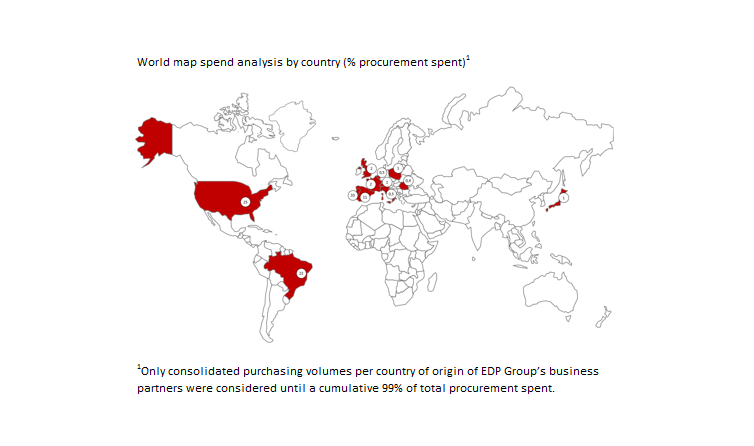During 2015 it was developed an extensive characterization study of EDP’s purchases, aiming a deeper knowledge about the economic, social and environmental impacts of EDP’s supply chain. EDP expects from now on to use these results for better definition of the priorities concerning sustainability management.

The purchase of fuel, the construction of energy facilities, the purchase and maintenance of equipment and service contracting related to distributional and commercial activities of energy are groups of supply categories that define the fundamental profile of the Group’s supply chain. On the map there is illustrated the origin of EDP suppliers by country and in the immediate tables the origin of purchases by EDP structure.
1) Fuel purchases not included.
2) In the total number of EDP Group suppliers, business partners supplying in more than one geography are accounted only one time.
3) EDPR not included.
4) North America – included: the USA, Canada and Mexico
5) All operations of EDP Renewables (considered: Belgium, Brazil, Spain, France, Italy, Poland, Portugal, UK and Romania)
1) Includes fuel purchases and services associated.
2) In the total number of EDP Group suppliers, business partners supplying in more than one geography are accounted only one time.
The tables below show the impact of EDP purchases under some dimensions. It is, however, a synthetic information that does not show the depth of the information available. The study, developed by PWC and based on ESCHER methodology, details data by: country (not only where EDP operates), relevant purchases categories and suppliers.
It can be highlighted the most relevant economic impacts:
- the employment volume induced by EDP in its supply chain which reached 177 thousand jobs and 326 million hours worked with direct suppliers representing 44% of the total workforce;
- the importance of the capital intensive purchasing represents 55% (raw materials, equipments), compared with 45% related to labour-intensive (provision of services);
- the value created by EDP purchases is mostly retained in the countries where EDP operates: retention of 70% of value of purchases, 59% of jobs and 79% of wages.
EDP, through its direct suppliers, is exposed to a relatively low social risk. Risks such as child labour, forced labour or occupational health & safety came out as very low risk control priorities should be given to low wages (0,27% of direct purchasing). The main risk from the social perspective came out as being the gender equity, representing 18,34% of direct purchasing.
Under the category “Country”, 7% of direct purchasing is exposed to political instability, rule of law ineffectiveness and government effectiveness fragility, but the most relevant risk is corruption, covering around 10,3% of direct purchasing.
However, when the scope is indirect purchasing, results are significantly different.
The table reveals a dramatic high increase of risk exposure, namely child labour (0,54%), forced or compulsory labour (0,39%), occupational health and safety (7,9%), excessive working hours (1,4%) and low wage (13,4%). Gender equity is still the most relevant risk, increasing to 25,7%. The increase of risks is also expressively present in the dimensions related to rule of law, government effectiveness and corruption.
Following this study, managing sustainability in EDP’s supply chain will need new processes in place to give EDP guaranties that direct suppliers endorses commitments in the improvement of labour and social conditions of its own supply chain.
EDP impacts on environment are also relevant. These are clearly linked to the environmental costs from extraction and transport of raw material, where gas and coal are dominant. EDP will continue this work, promoting energy efficiency initiatives on its suppliers, as well as the reduction of waste towards an improvement of the circular economy.
1) There is a difference between the values of these emissions and Scope 3 calculation. This is due to the exclusion of end-use consumption and net electricity purchases.